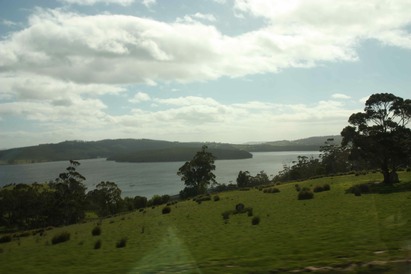
Less than a year later John Hayes was the next European to reach Adventure Bay. He had left Calcutta on a private voyage to New Guinea financed by English merchants in Bengal on 6 February 1793 with two ships (Duke of Clarence and Duchess of Bengal) and had quite literally headed via the Cape, landing in Bruny on 24 April and sailing on 9 June. In the meantime, he had discovered and named the Derwent, exploring it as far as New Norfolk, naming Risdon Cove and preparing maps and charts of the area, unaware that d’Entrecasteaux had done a much more thorough job of a similar task less than twelve months earlier. From Tasmania Hayes went on to New Caledonia, and the Louisiade Archipelago, making his way back to Calcutta on 5 December 1794 by way of Kupang, Surabaya, Batavia and Canton, where he sold the cargo he had picked up along the way at a tidy profit.
He obviously didn’t believe in taking short cuts.
George Bass and Matthew Flinders were in the process of demonstrating that Tasmania was an island when reached Fluted Cape on Bruny Island in the 25 ton sloop Norfolk on the 14 December 1798.
The French were back in the picture with the first purely scientific expedition to Australia, led by Captain Nicholas Baudin with two well equipped ships (Géographe and Naturaliste) and nine scientists including botanist Jean Baptiste Leschenault de la Tour, naturalist François Péron and cartographic surveyor Louis-Claude Desaulses De Freycinet.
Baudin had previous experience with scientific expeditions, with voyages to the Indian Ocean in 1792 and the West Indies in 1796, received his instructions on 24 April 1800 and sailed on 19 October, arriving off the West Australian coast in late May 1801 via Mauritius. The two vessels started working north from Cape Leeuwin, were separated, reunited in Timor and set off for another go at Australia’s southern coastline on 13 November. That brought them to Van Diemen's Land on 13 January 1802 and they spent a month in and around the D'Entrecasteaux Channel for more than a month before moving north.
The obvious French interest in the area was one of the factors that resulted in the settlement of Tasmania, with John Bowen’s party arriving at Risdon Cove less than two years later.
Around the same time, whalers and sealers were entering the area, with the English whaler Alexander operating off Adventure Bay as early as 1804 and there were no less than four whaling stations operating in Adventure Bay after the 1820s. At one time, there were eighty to ninety men engaged in whaling, operating from the shore with two schooners, two sloops and a large number of boats.